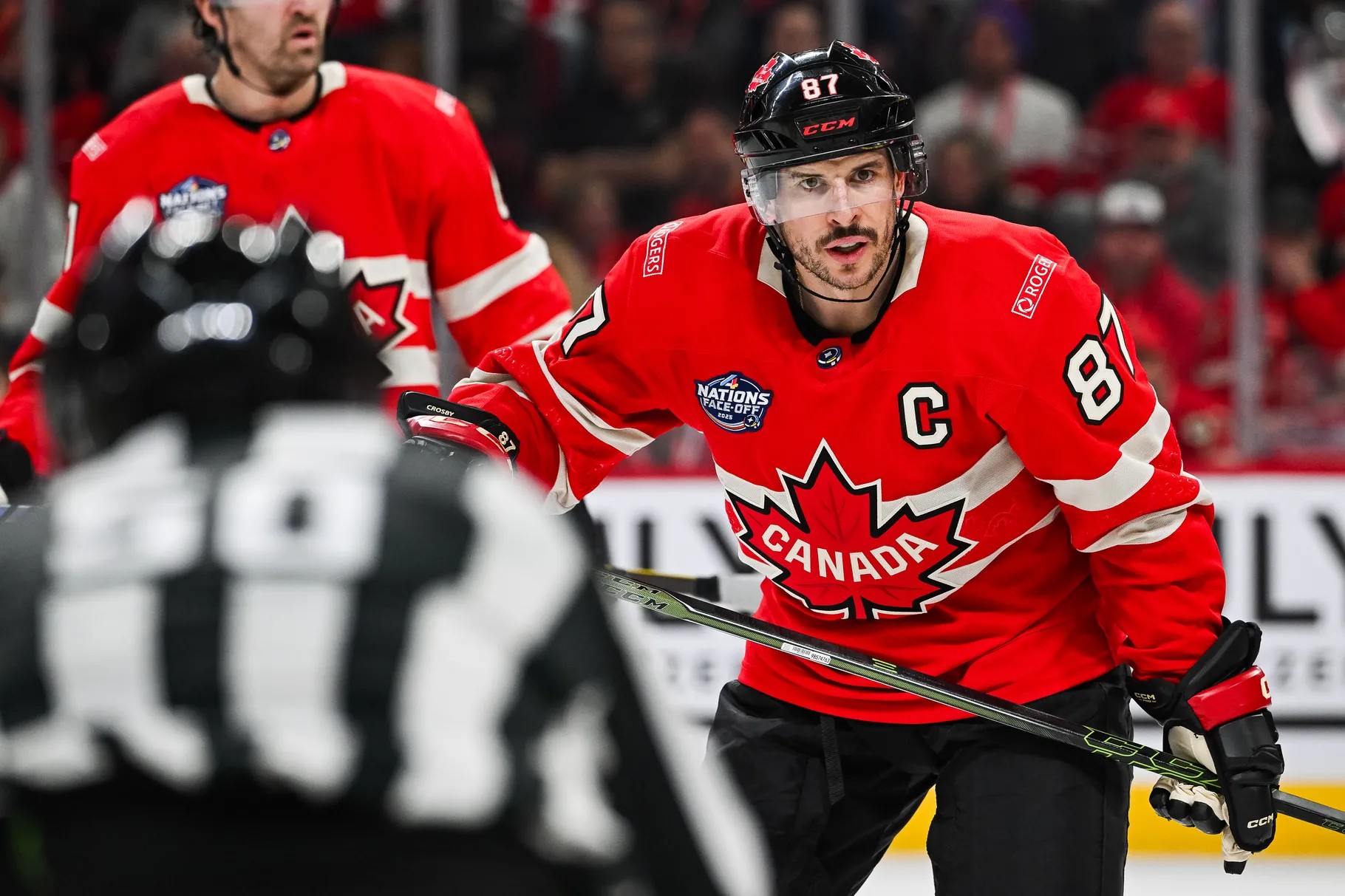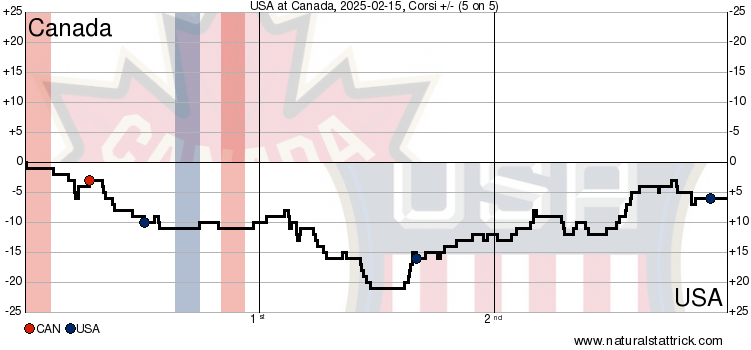The game started with a bang and ended with a whimper, but Team Canada is not out yet, even if they have their work cut out for them.
Your Canada-USA game in 10:
1. What an incredible, electric start to this game. Three fights happened in the span of nine seconds of gameplay. First, Brandon Hagel and Matthew Tkachuk squared off. Then, Sam Bennett and Brady Tkachuk. Then, when you thought it was over and we got a few seconds of game action, Colton Parayko and JT Miller squared off. Words can’t do it justice, but thankfully, ESPN posted the full sequence.
USA vs. Canada started off in MADNESS 😳
📺: ABC/ESPN+/Disney+ pic.twitter.com/BrWlXzMb7J
— ESPN (@espn) February 16, 2025
It’s worth adding that this is a collection of some of the most elite talent in the league, and this is how the game starts: ultra-emotional and physical. This tournament is in an NHL rink with NHL referees, and we saw the leeway that comes with this compared to international hockey rules.
We say it every year, but with all the skill in the league, the big games always tend to boil down to tight-checking, physical, grind-it-out hockey. With the most talent on the ice we have seen in nearly a decade, that’s exactly what we got, yet again. It needs to be part of a team’s DNA to win in the NHL.
2. After the third fight, the officials called a penalty on JT Miller, which was lousy in a sense but gave Canada a golden opportunity to open the scoring. The first unit sputtered as Sidney Crosby continually missed or was too slow to hit the backdoor play. The Americans got some momentum from the kill, but that was quickly squashed by a highlight-reel Connor McDavid goal.
When Drew Doughty hit McDavid in stride right in the middle of the neutral zone, it immediately felt like a goal was coming. McDavid had already beaten Zach Werenski just by receiving the pass in stride, and Charlie McAvoy was caught flat-footed. McDavid went wide with speed, faked cutting in, and flipped a backhand short side for an electric goal to give Canada the 1-0 lead.
3. That lead didn’t even last five minutes, as Team Canada got burned by the type of goal pretty well everyone with a rooting interest in Canada had been fearing.
On a simple 2v2 rush for Jack Eichel and Jake Guentzel, Eichel cut to the middle, drawing both defenders in and leaving some space to pass it to Guentzel on the outside, where he took a shot through the five-hole from a bad angle. It’s a shot Jodan Binnington must stop, even though Guentzel is an elite goal scorer. It wasn’t a dangerous angle.
That said, from that point forward, Binnington made several good saves to either keep the game tied or, eventually, to keep Canada within one goal. He’s probably going to receive some criticism, and this goal will be the standout moment, but Canada scored all of one goal on the night. Binnington kept it to two, but they aren’t winning that kind of goal support.
4. Speaking of the lack of offense, Canada attempted just six shots at five-on-five in the entire first period. They went to a few power plays, where they generated looks to make it seem like they created more offensively, but even then, they generated eight shot attempts on those two power plays, while the USA generated seven on their lone power play of the night.
The excitement from the fights, the early goal, and the power-play attempts (the USA went to a power play, too) masked just how lackluster Canada was at five-on-five overall in the period, which continued for the majority of the game.
5. In the second period, the game started to settle in. There were no more fights and no penalties in general for the rest of the game. It was pure five-on-five hockey, and both teams generated 10 shots on net (20 shot attempts for the USA to Canada’s 18) as the hockey was relatively even and came down to a few mistakes and missed opportunities.
Both teams generated some zone time, but Canada couldn’t create anything that truly tested Connor Hellebuyck, ultimately firing just 26 shots on net total for the entire game.
Jon Cooper did mix in some shifts with Crosby, McDavid, and MacKinnon on one line, but it was disjointed. Too many players—McDavid and MacKinnon included—were trying to make things happen all on their own rather than moving the puck around and working off of each other. Naturally, the goal in the period came from a Canadian mistake…
6. When a team is struggling to create offense, sometimes, a tendency to force it creeps in. On the game-winning goal for the U.S., Sidney Crosby forced it, and the USA capitalized.
There was no passing lane for Crosby, but he took a pass off the rush and tried to force it to the backside while the Canadian defensemen were on a line change. It got picked off, and the Americans were off to the races. On a 2v1, Dylan Larkin kept it and ripped a low blocker shot like he’s Bobby McMann (he’s scored twice from that spot on the exact same shot).
As good as Sid was in the first game, he really struggled in this game. In the third period, he forced another pass that also turned into a 2v1 for the U.S., but Guentzel missed the one-timer.
7. In the third period, the Canadian coaching staff really began to shake up their lines. They swapped McDavid and MacKinnon at first, keeping the winger pairings the same. Eventually, they moved Brayden Point up to play with McDavid and Crosby.
Nothing seemed to naturally click, and the USA defense did a really good job through the neutral zone with their gaps and protecting the blue line. Canada simply couldn’t gain the zone, and most of their forechecks were ineffective.
The Americans were not only getting the puck out but were cleanly breaking out often. Canada played the whole period from behind and generated just 18 shot attempts at five-on-five and eight shots on net overall — not even double-digit shots in a period they were losing, and they ultimately scored one goal at home.
Brock Faber and Jaccob Slavin both played over 25 minutes for the U.S., while Adam Fox and Zach Werenski played under 14. They went with lock-it-down, shutdown defense, boxing Canada right out.
Auston Matthews didn’t score, but he had a few chances and led all American forwards with 20:39. He was excellent defensively and had a huge backcheck in the second period to break up a 2v1.
8. Canada’s attack with the empty net at the end of the game is not why they lost the game, but it was a good example of their struggles to generate offense throughout the night. McDavid, Morrissey, and MacKinnon passed it around the perimeter as the USA boxed out the house with tight coverage, and Canada never came close to getting inside in any sort of dangerous way.
When they threw the puck to the net, Mitch Marner collected the rebound and rushed a pass to nobody, which resulted in a clear. Morrissey then dumped the puck in with zero forecheck going with speed, leading to an easy clear and an empty-net goal for the U.S. to ice the game.
Canada spent a lot of time dumping the puck in and failing to retrieve it, and they spent a lot of time not getting inside with the puck before turning it over. Both happened in quick succession with an extra man on the ice, leading to an empty netter to seal the game.
9. When the dust settles, and Canada has little time to digest what happened tonight, they need to have a serious conversation about their ice-time allocation.
Sam Bennett tied Connor McDavid and Mark Stone for the most shots on goal by a Canada forward with three, laid multiple big hits, had the big fight… and played 7:41. I’m not sure Canada had six forwards that were more capable of getting inside the big USA defense and causing havoc, let alone 11, but Bennett played the least of any forward.
Nathan MacKinnon played the fourth most of any Canadian forward, which needs no further explanation; it can’t happen. Sam Reinhart played over 15 minutes with prime linemates and power-play time but failed to record a shot on goal.
Short tournaments are extremely difficult to coach in a fluid sport like hockey; the coaching staff makes split-second lineup decisions while also trying to show enough patience to build chemistry. At the same time, it’s hard not to look back on this game puzzled by a number of lineup decisions. The staff didn’t do a good enough job identifying who was rolling, who was not, and changing things up accordingly.
10. With this win, the USA has clinched a spot in the finals, but Canada is still in control of its destiny due to Sweden losing in extra time (for a second time) to Finland. If Canada wins in regulation against Finland, it is guaranteed a spot in the final. Any loss will eliminate them, and a win in extra time against Finland would require Sweden failing to beat the USA in regulation for Canada to make the final.
In the 2010 Olympics, Canada lost to the USA in the round-robin. We know how it ended. Canada will now hope to travel the same path some 15 years later.

![Craig Berube on Joseph Woll leaving the game injured in Carolina: “Hopefully, it is not [serious], but I really liked the way Hildeby came in and handled it” Craig Berube, Toronto Maple Leafs head coach](https://mapleleafshotstove.com/wp-content/uploads/2025/09/berube-pg-sep-21-218x150.jpg)













![John Gruden after the Leafs prospects’ 4-1 win over Montreal: “[Vyacheslav Peksa] looked really comfortable in the net… We wouldn’t have won without him” John Gruden, head coach of the Toronto Marlies](https://mapleleafshotstove.com/wp-content/uploads/2025/09/gruden-post-game-sep-14-218x150.jpg)












![Craig Berube on Joseph Woll leaving the game injured in Carolina: “Hopefully, it is not [serious], but I really liked the way Hildeby came in and handled it” Craig Berube, Toronto Maple Leafs head coach](https://mapleleafshotstove.com/wp-content/uploads/2025/09/berube-pg-sep-21-100x70.jpg)







